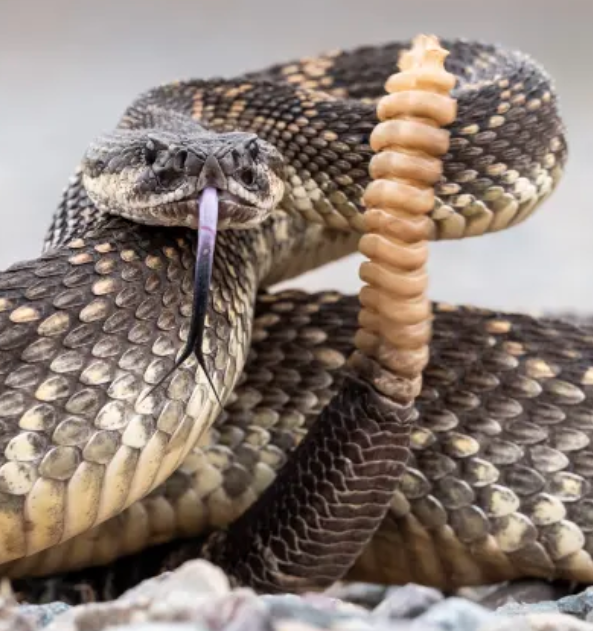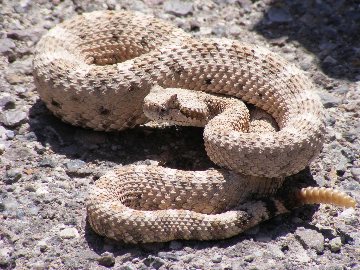Friday, January 17 2025
According to the Centers for Disease Control and Prevention, an estimated 7,000-8,000 people are bitten by venomous snakes in the  United States each year. On average, five will die. Snake season is typically mid-March to mid-November. During the colder months of the year, snakes experience a form of hibernation called brumation. So why worry about North American pit vipers such as rattlesnakes, copperheads and water moccasins in the winter? Bites actually can happen at any point. Snakes will occasionally wake up throughout the winter, especially if it’s warm and sunny, or if there is an earlier spring. They will get something to drink, spend time in a sunny spot, and then go back into their den. In southern states where the weather is much warmer year-round, snakes are always active. So it’s important to be aware of your surroundings no matter the season— as well as wearing snake gaiters to protect lower legs. United States each year. On average, five will die. Snake season is typically mid-March to mid-November. During the colder months of the year, snakes experience a form of hibernation called brumation. So why worry about North American pit vipers such as rattlesnakes, copperheads and water moccasins in the winter? Bites actually can happen at any point. Snakes will occasionally wake up throughout the winter, especially if it’s warm and sunny, or if there is an earlier spring. They will get something to drink, spend time in a sunny spot, and then go back into their den. In southern states where the weather is much warmer year-round, snakes are always active. So it’s important to be aware of your surroundings no matter the season— as well as wearing snake gaiters to protect lower legs.
What to do if bitten by a venomous snake. The first step you should take after a venomous snakebite is to stay calm. Don’t panic. Your goal should be to seek immediate medical attention. Most hospitals have the resources and expertise to be able to get you through it. The next step is to note the time the bite happened and remove any jewelry or clothing that may cover or restrict the extremity. If possible, call 911 for an ambulance, or have a friend or family member drive you to the hospital. It is better to get care closer to the time of the snakebite, but the main goal is to get treated soon after being bitten by a snake. Elevate the bitten extremity at heart level or higher to help decrease swelling.
What not to do if bitten by a venomous snake. After being bitten by a venomous snake, do not try to kill the snake or capture the snake. It is imperative to remember that the snake is afraid and is trying to get away from you. There is no need to waste time trying to harm or capture the snake. The most important step you can take is to get to the nearest health care facility so health care personnel can treat the wound. Contrary to some misinformation about treating a snakebite wound, victims should not cut the wound, try to suck the venom out of the wound, or use alcohol in an attempt to treat the wound. Do not apply heat or ice or use a tourniquet on the affected extremity. Do not drink alcohol or caffeinated beverages or take any drugs or medication prior to seeking care for the bite.
Symptoms of venomous vs. non-venomous bites. For individuals who may not know if they were bitten by a venomous or non-venomous snake, look out for these symptoms: within the first couple of hours after a venomous snakebite, the individual will often develop significant pain while trying to use the bitten extremity, and the individual will develop a fair amount of swelling and bruising.
Non-venomous bites are localized wounds that may have a small amount of tissue damage. With non-venomous bites, wash the bite with soap and water and observe it over the next 24-48 hours to make sure there are no signs of infection such as spreading redness or foul-smelling drainage. If there are signs of infection, make an appointment with a health care provider.
Treatment. While different health care institutions may have their own protocols for venomous snakebites, there are general steps that each institution will take to treat the bite. Early phases of care include bloodwork so the physician can determine whether the venom has gotten into the bloodstream, wound measurements, providing pain relief, and assessment for systemic symptoms. Health care providers will then observe the bite for any signs of rapid onset pain and symptoms of bruising, swelling and limited limb mobility. Patients could be evaluated by a medical toxicologist who coordinates care in conjunction with the admitting physician. Once patients have been stabilized with antivenom, they are usually admitted overnight for observation. Some form of treatment may continue after discharge depending on the severity and circumstances.
Sunday, October 15 2023
Rattlesnakes are most commonly encountered from spring through October, and then they are presumed to hibernate. But that's not exactly true, depending on where you live. Snakes are more reactive to consistently cold weather, rather than a change of seasons. Rattlesnakes are even known to move around during extended warm periods during winter months, especially if they hole up in a stump or other location that can be warmed easily by sunshine. Snakes become sluggish anywhere below 60 degrees° F, so as long as warmer temps prevail, as it seems to be doing this Fall, please be diligent and wear snake gaiters (lower leg protection) w hen outside raking leaves, stacking firewood , hunting, or hiking. A steady temperature drop is a signal for the snake to enter brumation (similar to hibernation), but that’s not nessarily happening yet. hen outside raking leaves, stacking firewood , hunting, or hiking. A steady temperature drop is a signal for the snake to enter brumation (similar to hibernation), but that’s not nessarily happening yet.
Snakes do not actually hibernate, rather they become less active during cold weather. It is called "brumation." Brumation is an extreme slowing down of their metabolism. Snakes are awake, but just very lethargic so you don't see them moving around. In late Autumn, snakes move back to the previous year’s den. If a sudden cold snap catches them before they get there, they may die if not fortunate enough to find a suitable secondary den. They usually do not stay long at the den entrance, but hurry in for the long winter sleep. A number of species may share the same den. For example, black rat snakes, timber rattlesnakes and copperheads commonly den together. Sometimes there will be as many as 100 snakes in one cave. A group site is called a hibernaculum.
Cold-blooded animals like snakes, fish, frogs, and turtles need to spend the winter inactive, or dormant, because they have no way to keep warm. Snakes will crawl into any area free from frost such as caves, hollow logs, holes under trees and stumps, under wood piles, in other animal's burrows, and occasionally in a person's basement, barn, or outbuilding. Snakes will increase their intake of food before brumation occurs, if they can. Not all snakes will survive brumation. A skinny snake will not survive. If the snake feeds heavily before they hibernate, and have digested their meal before the cooling starts, they will be OK. If food is in their stomach or intestines when they cool, it will rot and kill them. Vipers can also brumate during normal conditions, due to a loss of food, but normally when they become dormant it corresponds with extreme temperature changes.
On warmer days in late October and November, early spring, or even during winters, brumating rattlesnakes sometimes come out of their dens to bask in the sunshine. Nice sunny days that follow a long cold snap are often when people are surprised by rattlers. Just like humans, snakes head out to enjoy the sun and unsuspecting hikers can startle them and cause them to strike. Generally, rattlesnakes emerge from their pseudo-hibernation in March or April, or when the average daytime temperatures reach and remain about 60 degrees Fahrenheit (16 degrees Celsius) and higher.
The Centers for Disease Control and Prevention (CDC) estimates that 7,000 to 8,000 people get bitten by venomous snakes each year in the USA (mostly by the Western Diamondback Rattlesnake, Western Pygmy Rattlesnake, Timber Rattlesnake, Cottonmouth, Copperhead, and Coral snake), resulting in 8 to 15 deaths. That number is reason enough to always wear snake gaiters when in the desert or the woods. If you do, you won't have to worry so much about the temperature or the season.
Thursday, October 29 2015
Snakes are seen just about everywhere from spring through October, and then they are presumed to hibernate. But that's not always true. Snakes are more reactive to consistently cold weather, rather than a change of seasons. Rattlesnakes are even known to move around during extended warm periods during winter months, especially if they hole up in a stump or other location that can be warmed easily by sunshine. 
Snakes do not actually hibernate, rather they become less active during cold weather. It is called "brumation." Brumation is an extreme slowing down of their metabolism. Snakes are awake, but just very lethargic so you don't see them moving around. In the fall, snakes move back to the previous year’s den. If a sudden cold snap catches them before they get there, they may die if not fortunate enough to find a suitable secondary den. They usually do not stay long at the den entrance, but hurry in for the long winter sleep. A number of species may share the same den. For example, black rat snakes, timber rattlesnakes and copperheads commonly den together. Sometimes there will be as many as 100 snakes in one cave. A group site is called a hibernaculum.
Cold-blooded animals like snakes, fish, frogs, and turtles need to spend the winter inactive, or dormant, because they have no way to keep warm. Snakes will crawl into any area free from frost such as caves, hollow logs, holes under trees and stumps, under wood piles, in other animal's burrows, and occasionally in a person's basement.
Snakes will increase their intake of food before brumation occurs, if they can. Not all snakes will survive brumation. A skinny snake will not survive. If the snake feeds heavily before they hibernate, and have digested their meal before the cooling starts, they will be OK. If food is in their stomach or intestines when they cool, it will rot and kill them. Vipers can also brumate during normal conditions, due to a loss of food, but normally when they become dormant it corresponds with extreme temperature changes.
On warmer days in late fall, early spring, or even during winters, brumating snakes sometimes come out of their dens to bask in the sunshine. Nice sunny days that follow a long cold snap are often when people are surprised by rattlers. Just like humans, snakes head out to enjoy the sun and unsuspecting hikers can startle them and cause them to strike. Generally, rattlesnakes emerge from hibernation in March or April, or when the average daytime temperatures reach and remain about 60 degrees Fahrenheit and higher.
During a typical year, an estimated 45,000 people are bitten by snakes in the United States. That number is reason enough to always wear snake boots or snake gaiters when in the desert or the woods. If you do, you won't have to worry so much about the temperature or the season — use common sense to keep yourself safe. Hunters should be especially vigilant and wear snake protection!
|